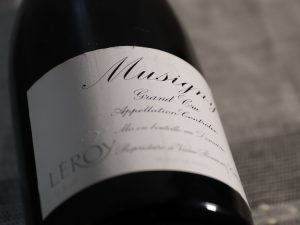
During her latest appearance on the BFM News channel’s investment segment, Angélique de Lencquesaing talked to Cédric Decoeur about the dynamic and exciting world of collectors’ whisky.
We’ve spoken recently about all the movement in the wine auction market which is attracting bidders around the world. But today we want to hear about spirits, as these are also interesting to collectors. What kind of spirits are we seeing on the auction market?
Well, before looking at more recent trends, it’s worth considering that tradition alcohols like Cognac and Armagnac have featured in our wine auctions throughout the last 20 years. For a long time, these have been considered an important addition to the collector’s cellar.
Overtime, whisky has come to the forefront with all its intricacies and long history. Chartreuse and rum have also been really successful at auction. Spirits represent a captivating side of the market, and they have a lot of the attributes required of an excellent collectors’ item.
Are we talking about a couple of bottles per catalogue, or more?
We’ve seen interest in spirits increase over the years which has, in turn, enriched our catalogues with this kind of bottle. To give you an idea, 2016 saw 400 spirits go under the hammer at iDealwine, and this number doubled by 2019. In 2020, it was closer to 1,000 bottles, and spirits were often going for the highest bids on the whole website.
In 2019, the hammer price of a 50 Year Glenfiddich – €28,981 – gave us the idea to create a separate website for spirits. In collaboration with La Maison du Whisky, we founded Fine Spirits Auction at the end of 2020, so we’re now celebrating its one year anniversary. The latest current spirits auction will close on the 10th of December.
And it’s mainly whisky that we see, right?
On Fine Spirits Auction, it’s clear that whisky makes up the vast majority of our auction lots, around 80% in terms of volume.
And are they all at inaccessible prices for us mere mortals?
It’s actually interesting to see the variety of whiskies on offer. Bottles that are bought to be consumed often go for approachable prices under €100, and some of these are already mature blends that hold some nice surprises when opened. Johnnie Walker, Black & White, White Horse, and Cutty Sark are just some of the examples to look out for.
A beginner’s question: why is whisky a collectors’ item?
Collecting is central to whisky’s history. At the beginning of the 20th century, whisky was mainly consumed in Scotland, Ireland, England, Commonwealth countries, and the US. During the prohibition era, (legal) whiskey production ceased in the US, then when the Second World War came around, distilleries across the world had to halt their work to aid the war effort. Things took off again in the 1950s, until the first petrol shock slowed everything down once again. Long periods of little to no whisky being produced have increased its rarity, a key factor for anything to become collectible.
With investment in mind, should we prioritise Scotch whisky?
Scotch whisky is a must-have for collectors of spirits. Aged whiskies are highly coveted, ones that were bottled after a long period of maturing in casks.
In the same vein, whiskies from a single cask are also sought after because they are much rarer. Macallan is a legend when it comes to this kind of bottle.
The history of whisky in Scotland is rife with twists and turns, shining success followed by distillery closures. This happened to Port Ellen on the Isle of Islay, which shut down in 1983. The list of legendary Scotch distillers and bottlers goes on and on. To cite just a few, Gordon & MacPhail began as a grocery shop and wine merchant, before developing its branch as a bottler for the finest Scotch distilleries. Their impressive stocks came from the likes of Glen Grant, Linkwood, Mortlach, Macallan, and Glenlivet. Certain whiskies have even been bottled without a mention of their origin, which certainly adds to the mystery…
But the appetite for collecting isn’t limited to whisky from one time and place…
No indeed. Since the early 2000s, we’ve seen interest in Japanese whisky gradually increase here. Of course, Japan has been crafting whisky for over a century now, and its production has exploded since the 1950s. These bottles tend to be blends made mainly for drinking.
Japanese whisky reached an international audience in the 2000s. There was a desire to try whisky from old distilleries, as well as those that were no longer making their precious spirits. Japan’s economic crisis in the 1980s was the main reason for this. For example, Karuizawa’s 1983 bottlings were the last full production before the distillery had no choice but to slow down and eventually close completely. A bottle of Karuizawa 29-Year 1983 fetched a hammer price of €17,936 on Fine Spirits Auction this year.
The most dynamic Japanese names on the auction market right now are Karuizawa, Nikka, and Hanyu – these are the oldest – alongside names like Chichibu, a distillery founded only in 2008.
Apart from these emblematic countries, whisky is made in many places now, including France?
Yes, an increased demand has seen supply broadening in many ways. Some formerly-closed distilleries have been reopened, and artisanal brands are more and more numerous. France is now home to quite a few good distilleries. Michel Couvreur is somewhat of a pioneer, and his family have taken over since his death, ageing whisky in wine and sherry barrels. The Jura region’s vins jaunes are also doing well at auction; those made by Stéphane Tissot are a good example.
You’ve mentioned increasing demand, who is buying whisky at auction?
Well, the first collectors were actually Italians, who started this trend in the 1970s. They bought bottles from Scotch distilleries that were little known at the time. Today, however, out biggest bidders for spirits are in Asia. In Europe, spirits collectors can be found in Germany, Sweden, and Belgium. In France, investing in spirits for a collection is spreading.
What are the buyer profiles you’ve identified at Fine Spirits Auction?
In our first year of spirits auctions, around 2,500 bottles have exchanged hands so far, and the bidders come from all around the world. France is still our top buyer country, and outside France, bidders from Germany, Singapore, Taiwan, and the US stand out.
If you buy a spirit as an investment, what kind of conditions should it be kept in?
The conditions for keeping a spirit are important, and they are also different from how we cellar wine. A whisky must be kept upright. For collectors, the packaging is really important, too, as it brings extra value to the bottle when kept intact for many years. Going back to Glenfiddich for an example, the 50-Year was produced just twice, and it comes from nine casks carefully selected in honour of William Grant’s nine children. The bottles were blown by hand, adorned with a silver plaque, and presented in a handsewn leather pocket. The attraction for collecting such products goes beyond the taste of what’s inside…in some ways, it joins up with the world of art.



